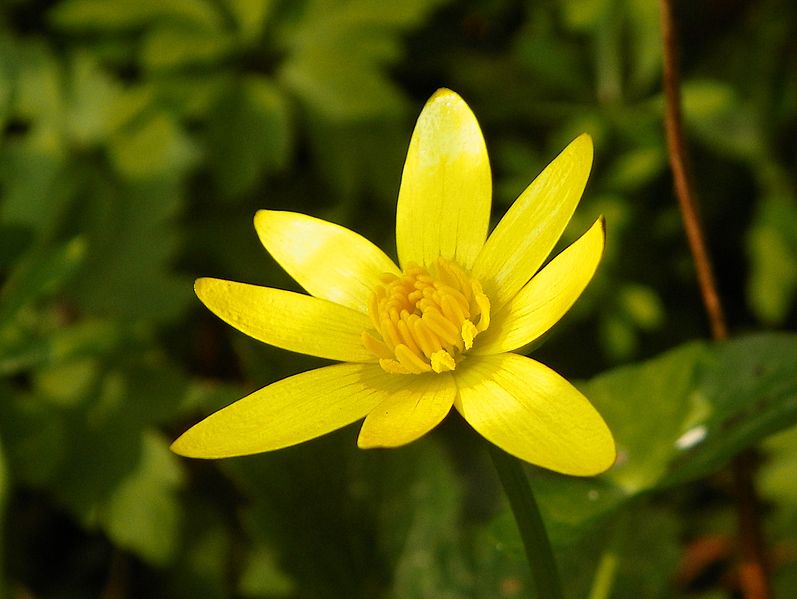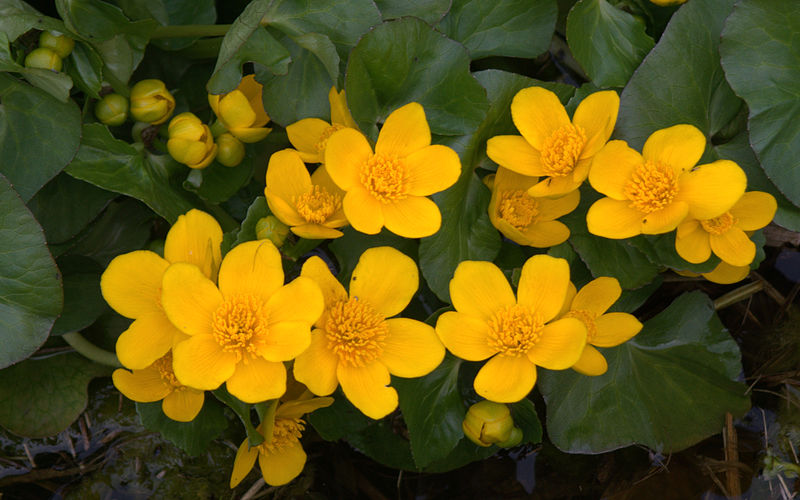
I’m not very good on flowers – but I know what I like.
I like the spring and I have noticed, at least I think I have noticed, that there are lots of yellow flowers around at this time of year. As well as the daffodils and primroses, there are aconites and celandines, and I have seen my first coltsfoot, marsh marigold and cowslips.
Why so much yellow? Tell me that! I’m just a poor bird guy, after all.

I think it is to attract pollinators. If you were to wear a yellow T shirt for your morning walk tomorrow (I doubt you will own one, but if you do and you wear it) you will attract lots of welcome and unwelcome insects. I have learnt that the hard way in my travels.
My garden is full of flowers of all colours at the moment.
They have evolved yellow pigment in order to lure insects away from yellow sticky traps.
Breeders of oilseed rape gave it yellow flars just to annoy people.
“…just to annoy people”
I once met a chap (ex-WT I think) who had an irrational dislike of OSR. Bizarrely this had nothing to do with the crop’s propensity to leach nitrate or it’s heavy requirement for pesticides, as I had assumed. His prejudice was based solely on its colour ! He considered it to be a terrible stain on the landscape. Each to their own I suppose.
I had once to endure a lecture from a hippie Harpie on the sheer horriblenessness of “that hideous, unnatural” OSR while travelling to a farm visit near Bath. She squealed with delight when we passed a “heavenly” field of blue linseed. Go figure!
Next – The Linnet …
Oil seed rape makes me sneeze. I also get a sore throat from it when in flower. I,m glad when it finishes flowering. Could it be a cause of “hay fever?”
Insect-pollinated species don’t have easily wind-blown pollen. I think it’s generally accepted that tree and grass pollen account for most hay fever. OSR is known to affect some people in the way you describe – this is ascribed to direct reaction to volatile compounds rather than allergic response to pollen. But I guess it doesn’t matter which, if you are susceptible.
In fact, OSR is both wind and insect pollinated – a condition that’s called “ambophily” (therefore the plant is described as “ambophilous”). It’s a form of hedge-betting in case insects are not available due to weather conditions and is found in other species, but is far from common.
It’s something I’ve wondered. There also seem to be more blue and purple flowers in late summer/autumn. Exceptions to any rule of course.
It’s all to do with evolution – the survival of the ‘yellowist’
I,m not a botanist, more of a flower spotter, if there is such a thing but walking about looking for flowers I also notice birds and butterflies etc. I don,t think anyone with a love of the countryside would only look at one subject. I find “birders” are a strange bunch though. They seem to think no-one but the “inner circle” could see a rarity. A lot of birders are very clique-ish. They race from one end of the country to put a tick in a book and don,t bother to study the bird or its requirements. Bird “twitchers” are in a competition against each other rather than enjoying the pleasure of watching the subject they pursue then race off to the next quarry. What is it all about? I have recorded about 70 species of birds from my small garden in a very large village, including harris hawk, ringed necked parakeet, raven, woodcock, last week there was a male blackcap. What have other non birders seen in their gardens?
a swallow! 2 days ago.
Wild flowers seem to be mostly shades of white, yellow and purple. The exceptions, like poppies, really stand out.
Most yellow spring flowers, but not all, have the ability to actively raise their temperature. They also can passively raise their temperature by absorbing a certain proportion of sunlight. Many yellow flowers have a bowl shaped form which enhances this process. Bees actively seek out these warm feeding stations which to them is like going for a hot sweet drink in a nice warm café. As the bees feed the flower helps them raise their body temperature. The bees have a robust and rounded body shape which helps them maintain a temperature allowing them to fly unlike many smaller pollinating insects which cannot venture out when the weather is cooler. The flowers have evolved to attract the bees which will pollinate them.
http://www.academia.edu/3185374/Warm_flowers_happy_pollinators
Brilliant! A real botanist’s answer to a birders Q. Mark will like that. We might even turn him into a well rounded ecologist yet.
Dave – great comment, thank you.
How does a bee orchid know what a bee looks like in order to copy the bee?
Diapensia – I guess it asks Richard Dawkins
He does tend to drone on
Who is Richard Dawkins?
Interesting! I had ponderings of this sort of thing a lot in Shetland…. the different stages of season seemed to bring out successional phases of flower colour, with I think many of the very early and very late flowers seeming to be yellow? Like Tormentil and Marsh Marigolds and the like. Multitudes of pinks and purples and whites through summer and then the lovely burnt red of the peaty grasses and mosses in Autumn…..
I read somewhere that the season’s changing fashions for colour is thought to be linked to the colours that different pollinators are better at seeing through the year – if your pollinator can see yellow, it pays to be in flower when they are around. Haven’t seen it in a peer reviewed journal though! Blue are often high / late summer, Pinks and purples tend to be after the spring yellows (there is definately a late yellow flush). With Gorse, there are yellow flowers whenever kissing is in season.
Of course our reaction and observation of colour in the environment might be as much to with ourselves as the environment itself. I find the calming blue of flax fields easier on the eye than Rape.
We should make more of the colours and textures of the environments we love: it is an important aspect of our experience of nature. What I love best about Dorset’s heaths is the incredible changes of texture and colour they produce through the year. But they have barely woken yet.
It is worth investigating the interaction of pollinators with the UV reflectance of flower pigments. What humans describe as yellow may be only our proxy for what certain pollinators can see.
The article Dave cites is fascinating, though it seems not to answer the question “why more yellow flowers in spring”. Given that flower temperature is important, it points out that one would therefore expect flowers to be darker so as to absorb more heat. But in fact no correlation is observed between flower temperature and colour and “more research is needed”. Black tulips perhaps.
“Who is Richard Dawkins?”
Lalla Ward’s husband
Our garden has colour phases and most of it is naturally seeded flowers (with the help of the local squirrel who has ‘donated’ quite a few bulbs from the old lady who used to live next door). The first phase is always yellow and always brings light where the lesser celandines flourish. The next phase is white and then it goes into the flamboyance of oranges and reds. I have tended to think it was a natural boost to the rare sunshine amounts at this time of year, maybe the pollinators are seeking warmth from the sun and the yellow is a con trick for them? Works for us!!!
There’s been a lot of speculation in the natural history literature about the way in which flower colour seems to vary predictably according to time of year. But if I recall correctly the few scientific papers that have addressed this question, it’s actually a myth. First of all, there are lots of plants which don’t have yellow flowers which flower in the spring (bluebells, various Prunus species, wood anemones, etc.). But yellow is such a distinctive (even emotive!) colour that we notice it more than others.
Secondly (as someone noted above) “yellow” to human eyes can look very different to an insect, depending upon the amount of reflectance or absorbance in the UV part of the spectrum. So we can’t assume that the yellow flowers we see at the moment look the same to the pollinators that visit the flowers.